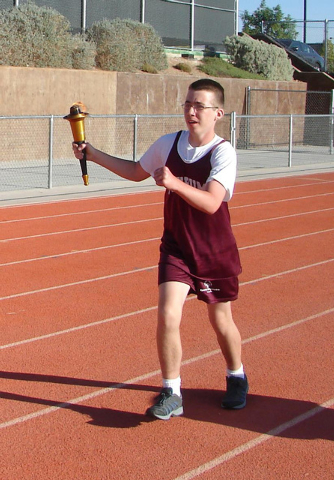
After seven years, the Special Olympic Torch run returns to Nye County. According to the Special Olympics Nevada, the state has summer games each year in Reno and each year Nevada law enforcement agencies are guardians of the torch, known as the “Flame of Hope.” The law enforcement agencies also help raise money for Special Olympics.
Steve Cabrales, the director of the torch run in Nevada, says the run will start in Southern Nevada on May 16 and run from Hoover Dam into Henderson and then Las Vegas. He said just this leg will involve about 100 law enforcement personnel. On May 17 it will come to Nye County and make its way north. Finally, it will arrive at the games on May 30 at the University of Nevada, Reno’s Mackay Stadium.
Cabrales said he got involved with Special Olympics before he retired from the Nevada Highway Patrol at 30 years. He has been involved with Special Olympics more than 10 years.
“I got involved with Special Olympics when I was working with the Highway Patrol and I served on the executive committee. When I retired I got the job as director of the torch run,” he said.
Cabrales explained the involvement of law enforcement in the run as two fold, “Law enforcement internationally has come on board with this run. Law enforcement has chosen Special Olympics to be their charity of choice and our officers have become the heroes to our athletes.”
The run involves more than 3,500 law enforcement officers throughout the state. County, state and federal officers are involved, including the military. Funds are raised through a variety of activities in Nevada, such as, Tip-A-Cops, Polar Plunges®, T-shirt sales and events created by local law enforcement personnel and Special Olympics staff.
The torch run started in 1981, when Wichita, Kan. Police Chief Richard LaMunyon saw a need to raise awareness of and funds for Special Olympics.
Cabrales explained that during the run, officers will not only run alongside each athlete, but will also help carry the torch hand-and-hand with the athletes. The officers will protect and guard the Flame of Hope. They will guard it all the way to the opening ceremony.
The summer games for Special Olympics will be track and field and aquatics.
Jim Soltz is the new area director for Special Olympics in Nye County. He took over from Kay Jones, who had been the director for 17 years. This will be the first time he has helped organize the run.
“Kay is the greatest guardian angel the organization could have. I got involved as a coach to help my daughter. They then asked me to do a parent advisory group. I then was asked to be the director. I am now learning all the things that Kay did,” Soltz said.
The director has been active in Special Olympics for seven years and even ran the torch run when he was in law enforcement in California.
“I have been involved in Special Olympics since my daughter was 8 years of age on and off. My daughter is now 40 and has Down Syndrome,” he said. “It takes law enforcement to make this happen. I decided to see if I could make this happen here since I had done it before. I thought if they had a torch run in Vegas we ought to have one out here. Let the athletes experience all that they could experience,” Soltz said.
According to Soltz, Nye County Undersheriff Rick Marshall was instrumental in helping with the Nye County portion of the run. Marshall said his department was excited to have the torch run back.
Thus far, the following deputies will be running with Nye County athletes: Harry Means, KayCee Otteson, Christopher Sehnert, Carina Skiles and Harry Williams.
Sgt. Carlos Rivera of the Nevada Highway Patrol will be escorting the group to the sheriff’s office. There will be 16 athletes going to Reno for the games from Nye County. The parents are also invited to walk with the athletes.
The run in Nye County will start at the Nye County commissioners building at 9 a.m. and we will run down Highway 160 to Basin and up to the Sheriff’s Department.
“I wanted to keep it conservative because I didn’t know how many runners I would get. It’s about 3.4 miles. Our athletes have different abilities so we tailored the run/walk to their needs,” Soltz concluded.